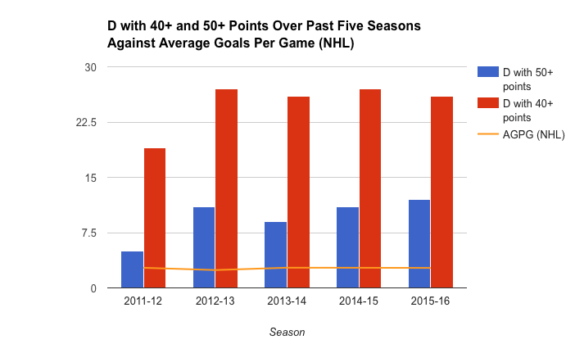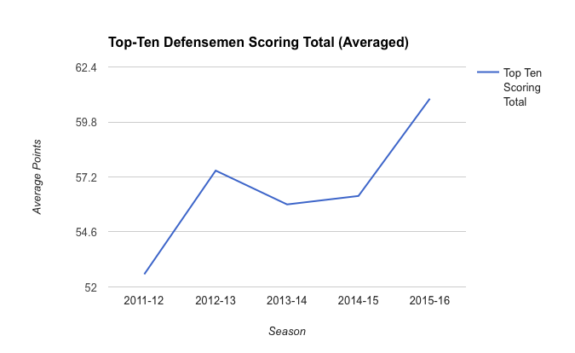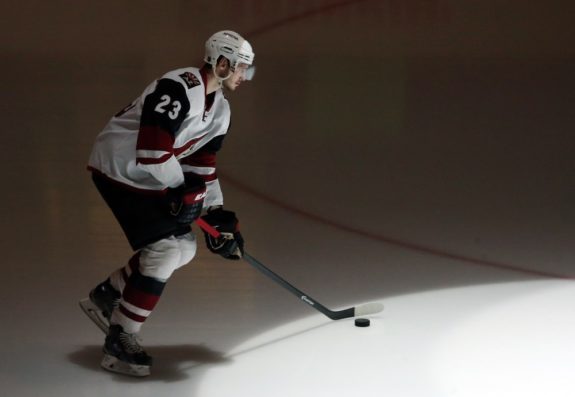The NHL’s product is fast evolving. Year-after-year, coaches, players and systems adapt to gain a competitive edge over their opponents. As a fantasy manager, the onus is on you to do the same. You must stay on top of trending value, positional scarcity, and up-and-coming NHL teams to ensure you’re optimizing the production of your squad. One trend you undoubtedly noticed? The rise of the D-man in fantasy hockey.
You might be thinking, ‘well, yeah, Karlsson and Burnsie have been ripping it up as of late, but I wouldn’t say it’s a trend.’ This mentality, although not entirely inaccurate, may cause you to sleep on defenseman come draft day and, in turn, hurt your chances of winning your league.
Why You Should Be High on Defensemen Come Draft Day
Over the last five seasons, upper-tier defensive production has risen while overall goals scored per game is on a soft decline. If you look at the numbers plainly—say, the quantity of defenseman scoring 40 or more and 50 or more points over the past five seasons—you aren’t really struck by a trend. As seen below, it varies slightly season-to-season, but overall, one could deduce that production is fairly stable from the back-end.

However, if you dig a bit deeper and examine the ‘upper-tier’ of offensive defensemen (i.e. the top-ten producing defensemen each year) a trend does emerge. These top-ten defensemen are becoming more formidable and producing more. Below is a depiction of the total scoring from top-ten defensemen over the past five seasons. You’ll notice the average point total of these ten skaters each year has grown from 52.6 points in 2011-12 to 60.9 points in 2015-16. That’s quite a leap.

Why are Defensemen Scoring More?
Brent Burns goes bardown to open the scoring pic.twitter.com/ebV9SX2XJA
— Brady Trettenero (@BradyTrett) June 10, 2016
As seen in the graph above, average goals scored per game in the NHL is on a slight decline—from 2.73 in 2011-12 to 2.71 last season in 2014-15. This can be partly attributed to the ever-increasing quality and athleticism of goaltenders. Case and point: average save percentage has increased from .914 to .915 over the past five seasons and goals against average has dropped from 2.54 to 2.51 in the same time frame. Perhaps team defence is tighter, but it’s easy to look around the league at the quality of starters (e.g. Price, Holtby, Bishop, Rask, Jones, Luongo, Gibson, Crawford, Dubnyk, etc, etc.) and appreciate how we arrived at those numbers.
So, how have coaches reacted to better goaltending? By getting defensemen engaged in the offense. Faster transitions, moving the puck up the ice quicker to generate odd-man rushes, more point shots with traffic and, I’m sure, a plethora of additional strategies designed to open up the ice and create space for goal scorers. These tactics have evolved over this period and, it’s my belief, that this has created a more acute responsibility on the team as a whole to score and not just the forwards. Defensemen with this skill set are uniquely positioned to jumpstart a team’s offence and establish effective counter attacks.
It is interesting to note that the rise of the upper-tier d-man is not exclusively tied to powerplay opportunities either. Average powerplay opportunities per game have actually decreased from 3.31 in 2011-12 to 3.11 in 2015-16. This means these players are integrated into the offence at even-strength as well, which speaks to the great ability of these players to take risks successfully and balance their offensive and defensive responsibilities.
The Erik Karlsson Effect

It’s impossible to talk about an increase in upper-tier defensive scoring without acknowledging the pinnacle of that upper-tier, Erik Karlsson. Karlsson almost flies under the radar with how consistently he produces more-than-elite numbers—he alone undoubtedly factors into the growth of overall defensive scoring year-over-year as well. Take a peek at his past five seasons:
- 2011-12: 78 points
- 2012-13: 14 points in 17 GP
- 2013-14: 74 points
- 2014-15: 66 points
- 2015-16: 82 points
That is one impressive body of work. Karlsson is a generational player who runs his team’s offence from the back-end. His ability to open a game up and generate scoring chances by taking risks has certainly paved the way for coaches to approach team offence from a different perspective, for players like PK Subban and Brent Burns to be embraced as core offensive contributors.
The Fantasy Takeaway
Okay, so defensemen are becoming more important to a team’s offence and scoring more. How should this inform your strategy come draft day? Well, firstly you should value elite D on par with top-end forwards. Beyond your own analysis of category coverage and your team’s needs, you can’t overlook the fact Karlsson was outscored by only three players while Burns was outpaced by only ten last season. Shots on goal, power-play points and hits aside, that’s elite offensive production. Draft accordingly.
The upper-tier of defensemen is rife with quality options for the upcoming campaign. Make sure your team is stocked up on 2-3 of these players. I’m referring to the likes of predatory-juggernauts PK Subban and Roman Josi, dynamic power-play quarterback, Oliver Ekman-Larsson, the smooth-skating Kris Letang, Dallas PP-quarterback, John Klingberg, the mighty Dustin Byfuglien, Drew Doughty, Shea Weber, Keith Yandle, Shayne Gostisbehere, Kevin Shattenkirk, Mark Giordano, to name a few. These players are conduits to their team’s offense and the catalysts in the transition from defending to attacking.

I really liked what Arizona general manager, John Chayka, said this offseason: “Defense isn’t about defending, it’s about getting the puck in the forwards’ hands.” From the mouth of a forward-thinking NHL exec to your ears. This is how defensemen are now evaluated—it goes beyond being able to shut down an opponent and now accounts for their ability to get that piece of rubber back and, in turn, jump-start an offense. The Erik Karlsson’s, Brent Burns’s and PK Subban’s of the world could just be the new archetype and the reason top-tier defensive scoring is on the rise.
Do yourself a favour come draft day and ensure you have one or two top-tier defensemen on your team. These D might just transition your fantasy team from middling contender to League Champion.